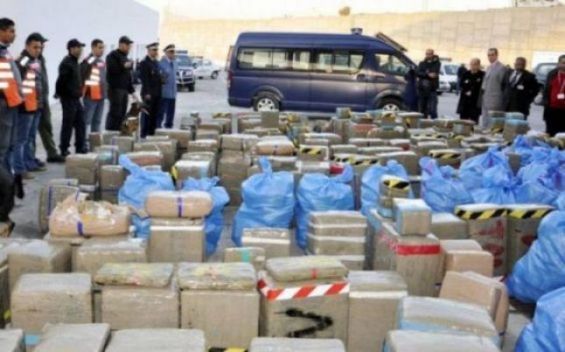Border closure and the measures taken to prevent the spread of the novel coronavirus have had consequences on the drug trafficking market too.
Some countries, like Morocco, have recorded large drug seizures since the start of the pandemic. The United Nations Office on Drugs and Crime (UNODC) believes that despite the health crisis, large-scale drug trafficking is still present. Countries have even reported an increase in operations to combat this illicit trade, the result of strengthening controls, initially intended to enforce the state of health emergency.
In the 2020 edition of its world drug report, the UNODC devotes a section to these seizures, indicating that after the United States, South America is the second largest area for cocaine trafficking in the world. It is directed towards Western and Central Europe, which represent the second largest cocaine market in the world after the US. The main points for transporting the goods remain mainly Morocco, Spain, Belgium and the Netherlands.
Morocco, point of trafficking cocaine, psychotropic drugs and cannabis
In the region, drug trafficking is gaining importance, as evidenced by the global seizures of cocaine in Africa, which increased from 1.2 tonnes in 2015 to 5.6 tonnes in 2018. The largest quantities of cocaine are seized mainly in Morocco, in Algeria, Namibia, Mozambique, South Africa and Nigeria.
Seizures in African countries in 2019 suggest that the total quantities intercepted may have reached «an all-time high of over 20 tonnes across the region» for the year. In February 2019, 9.5 tonnes of cocaine were found aboard a single Russian boat from Latin America, supposedly transiting through Morocco and bound for Portugal. The report notes that in August 2019 during a single seizure, Morocco got hold of three tonnes of cocaine near the beach of Sidi Rahal, which confirms the growing importance of the trafficking route.
UNODC confirms that non-medical use of opioids is reported in many countries. The phenomenon is present especially in West and North Africa, as well as in the Middle East, where tramadol is increasingly gaining ground. This is also the case for North America, where hydrocodone, oxycodone, codeine, tramadol and fentanyl are increasingly popular. The largest ecstasy seizures in Africa in 2018 were reported in Morocco. The stamps come mainly from the Netherlands and Belgium, destined for the domestic market.
Adapting drug trafficking networks to the health crisis : a challenge
Morocco also remains an area conducive to the production and export of cannabis. «Over the period 2008 to 2018, the largest seizures of herbal cannabis in the world took place in the United States, followed by Mexico, Paraguay, Colombia, Nigeria, Morocco, Brazil, India and Egypt», wrote UNODC. Most of the cannabis of Moroccan origin is destined for Europe, shipped mainly to Spain.
«For many years, including during the period 2014-2018, Spain has been identified by other European countries as the main point of departure and transit for cannabis resin, followed by the Netherlands».
But in another register where drug trafficking adapts to the health crisis, groups have been pushed to find new routes and other methods, such as trafficking via the darknet and mail shipments, says UNODC. The pandemic has also led to opioid shortages, which has prompted consumers to seek out more readily available substances such as alcohol, benzodiazepines or synthesized drugs.
UNODC fears that governments will reduce the budgets allocated to prevention and awareness-raising about the dangers of drugs, drug addiction services and treatment and medically monitored consumption.




 chargement...
chargement...












